Chart Color Schemes
est. as @ -- *
ABS ERP | -- people | --
2021 Census | -- people
Sales Activity
Curious about local property values? Filter the chart to assess the volume and appreciation (including resales) trends and regional comparisons, or scroll to the map below view this information at an individual property level.
Find a Recent Sale
Sales Detail
Population
Karnup lies within the top 10% of areas nationally in terms of population growth performance according to AreaSearch analysis of short and medium-term trends
Karnup's population was approximately 2,764 as of August 2025. This figure represents an increase of 668 people from the 2021 Census count of 2,096 individuals, marking a growth rate of 31.9%. The change is inferred from the estimated resident population of 2,524 in June 2024 and an additional 209 validated new addresses since the Census date. This results in a population density ratio of 51 persons per square kilometer. Karnup's growth rate exceeded both national (8.6%) and state averages, positioning it as a regional growth leader. Interstate migration contributed approximately 51.6% to overall population gains during recent periods, with all factors including natural growth and overseas migration being positive contributors.
AreaSearch uses ABS/Geoscience Australia projections for each SA2 area, released in 2024 with a base year of 2022. For areas not covered by this data, AreaSearch employs growth rates by age cohort provided by the ABS in its latest Greater Capital Region projections (released in 2023, based on 2022 data). Future population trends suggest significant increases in top quartile statistical areas nationwide, with Karnup expected to grow by 711 persons to reach 3,475 by 2041, a total increase of 17.0% over the 17-year period.
Frequently Asked Questions - Population
Development
AreaSearch assessment of residential development activity positions Karnup among the top 25% of areas assessed nationwide
Karnup has received approximately 65 dwelling approvals annually over the past five financial years, totalling 327 homes. As of FY-26, 13 approvals have been recorded. On average, 1.5 people move to the area each year for each dwelling built between FY-21 and FY-25, indicating balanced supply and demand dynamics. The average expected construction cost value of new dwellings is $366,000, reflecting more affordable housing options compared to regional norms.
In FY-26, Karnup has seen $157,000 in commercial approvals, demonstrating its predominantly residential nature. Compared to Greater Perth, Karnup records 233.0% more development activity per person, offering buyers greater choice and indicating robust developer interest. Recent development has been entirely comprised of detached houses, maintaining the area's traditional low density character with a focus on family homes. With around 39 people moving in for each dwelling approval, Karnup shows characteristics of a growth area. Population forecasts indicate Karnup will gain 471 residents by 2041.
Based on current development patterns, new housing supply should readily meet demand, offering good conditions for buyers and potentially facilitating population growth beyond current projections.
Frequently Asked Questions - Development
Infrastructure
Karnup has emerging levels of nearby infrastructure activity, ranking in the 26thth percentile nationally
AreaSearch has identified a total of 21 projects that are expected to impact the area significantly due to changes in local infrastructure, major projects, and planning initiatives. Among these key projects are The Gardens Estate - Lakelands, METRONET Karnup Station Precinct, Lakelands Residential Development Stage 3, and Lakelands Town Centre. The following list details those projects that are likely to be most relevant:.
Professional plan users can use the search below to filter and access additional projects.
INFRASTRUCTURE SEARCH
 Denotes AI-based impression for illustrative purposes only, not to be taken as definitive under any circumstances. Please follow links and conduct other investigations from the project's source for actual imagery. Developers and project owners wishing us to use original imagery please Contact Us and we will do so.
Denotes AI-based impression for illustrative purposes only, not to be taken as definitive under any circumstances. Please follow links and conduct other investigations from the project's source for actual imagery. Developers and project owners wishing us to use original imagery please Contact Us and we will do so.
Frequently Asked Questions - Infrastructure
METRONET Karnup Station Precinct
New railway station on the Mandurah Line at Karnup, integrated with a transit-oriented precinct delivering approximately 2000 dwellings, community facilities, retail and public open space across 35 hectares. Structure planning is progressing and the Metropolitan Region Scheme amendment to rezone land for urban development was gazetted in May 2025.

Lakelands Town Centre
A major mixed-use precinct serving the northern Mandurah corridor, anchored by the Lakelands Shopping Centre (completed 2017) and the new Lakelands Train Station (completed 2023). The precinct integrates retail, civic, and transit facilities, including the Lakelands Library and Community Centre. Ongoing development includes a new Mixed Business Sub-Precinct offering large format showrooms and commercial spaces, alongside continued residential expansion within the master-planned estate.
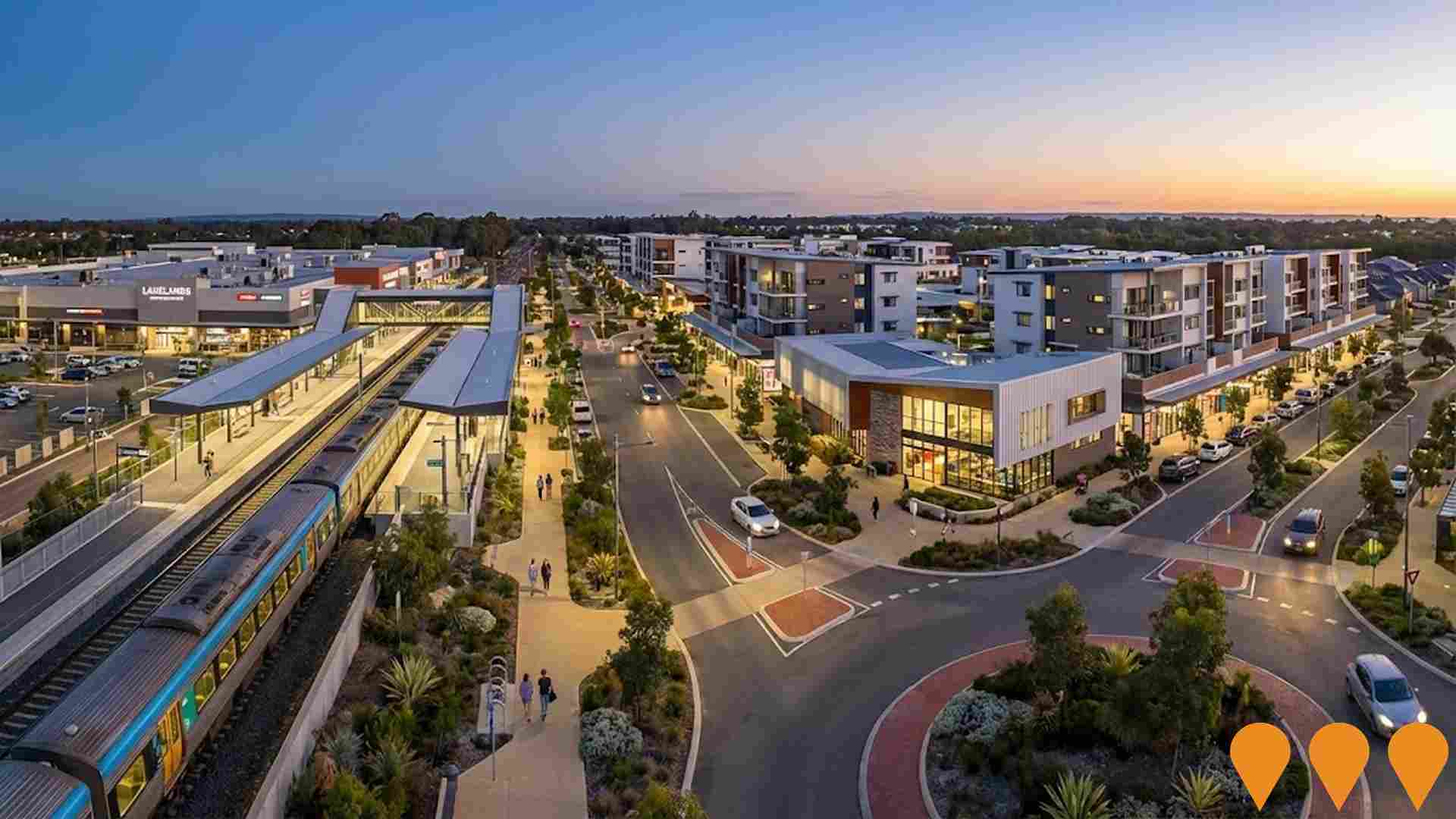
Lakelands Station
New METRONET infill railway station on the Mandurah Line between Warnbro and Mandurah. Opened 11 June 2023 with two side platforms, pedestrian overpass, 8-stand bus interchange, kiss-and-ride, secure cycle storage and a 400-bay car park. Provides an approx. 50-minute commute to Perth CBD and relieves pressure on Mandurah and Warnbro stations. Station is future-proofed for escalators, more lifts, a kiosk, fare gates and a customer service office as demand grows.

Lakelands Shopping Centre
Major retail destination featuring Woolworths, Coles, Kmart, specialty stores, food court, and medical facilities. Anchors the growing Lakelands community with convenient shopping and services.
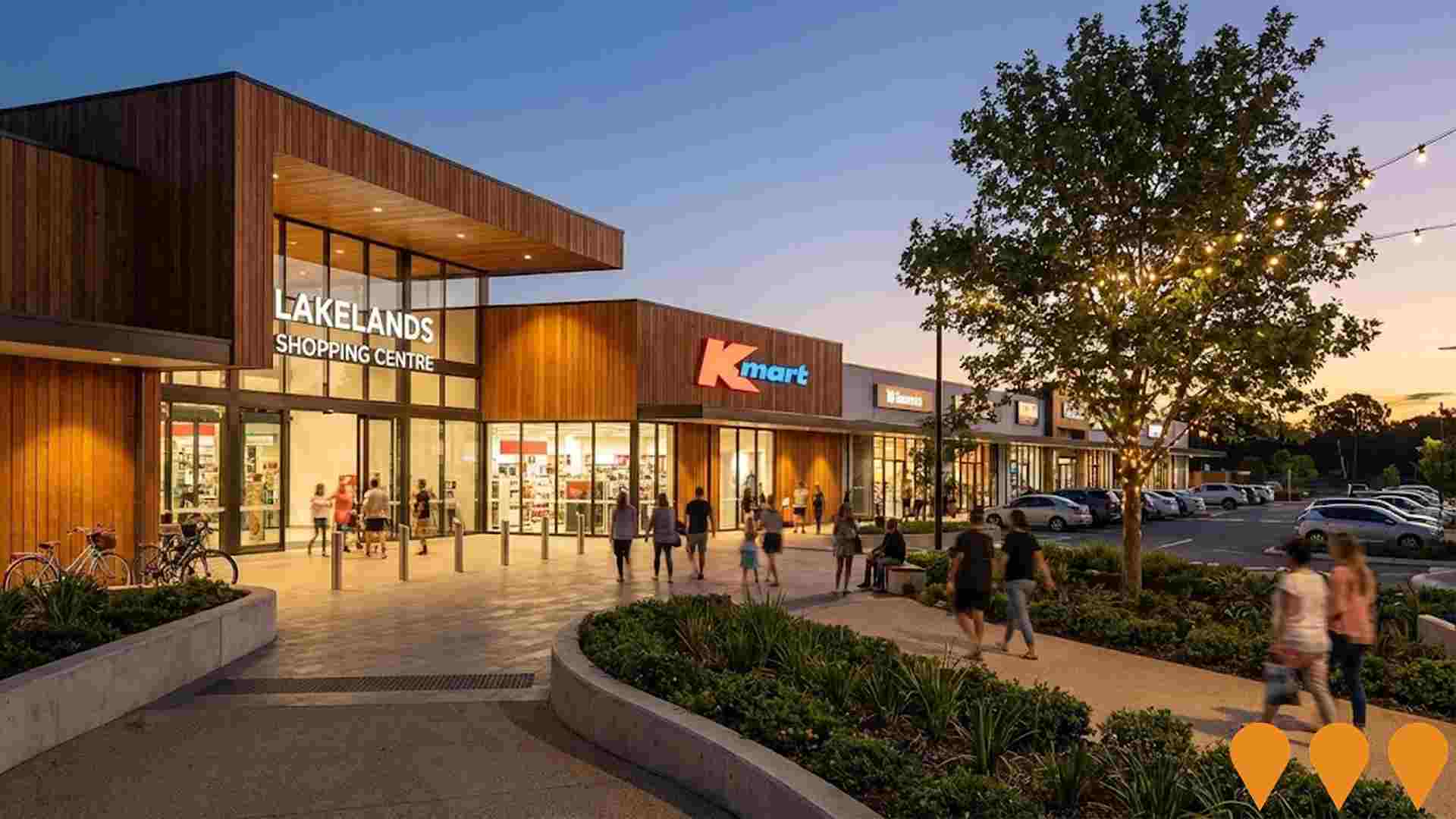
Lakelands Arterial Road Upgrade
Major road infrastructure upgrade to improve traffic flow and safety in the Lakelands area. Includes road widening, new intersections, cycling paths, and improved pedestrian facilities.
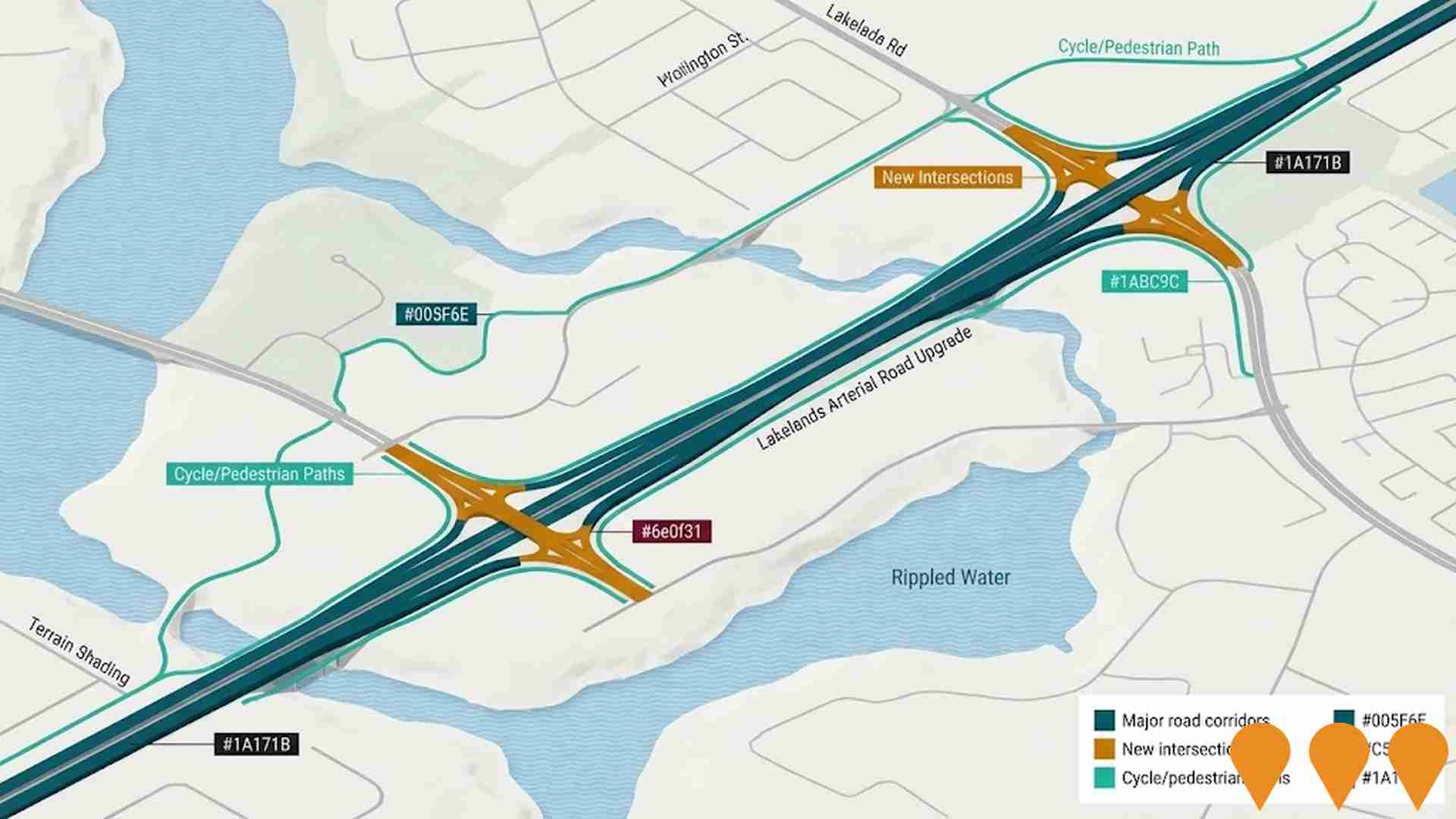
Golden Bay Local Centre
Future neighbourhood retail centre planned for Golden Bay including supermarket, specialty shops, medical centre and childcare.
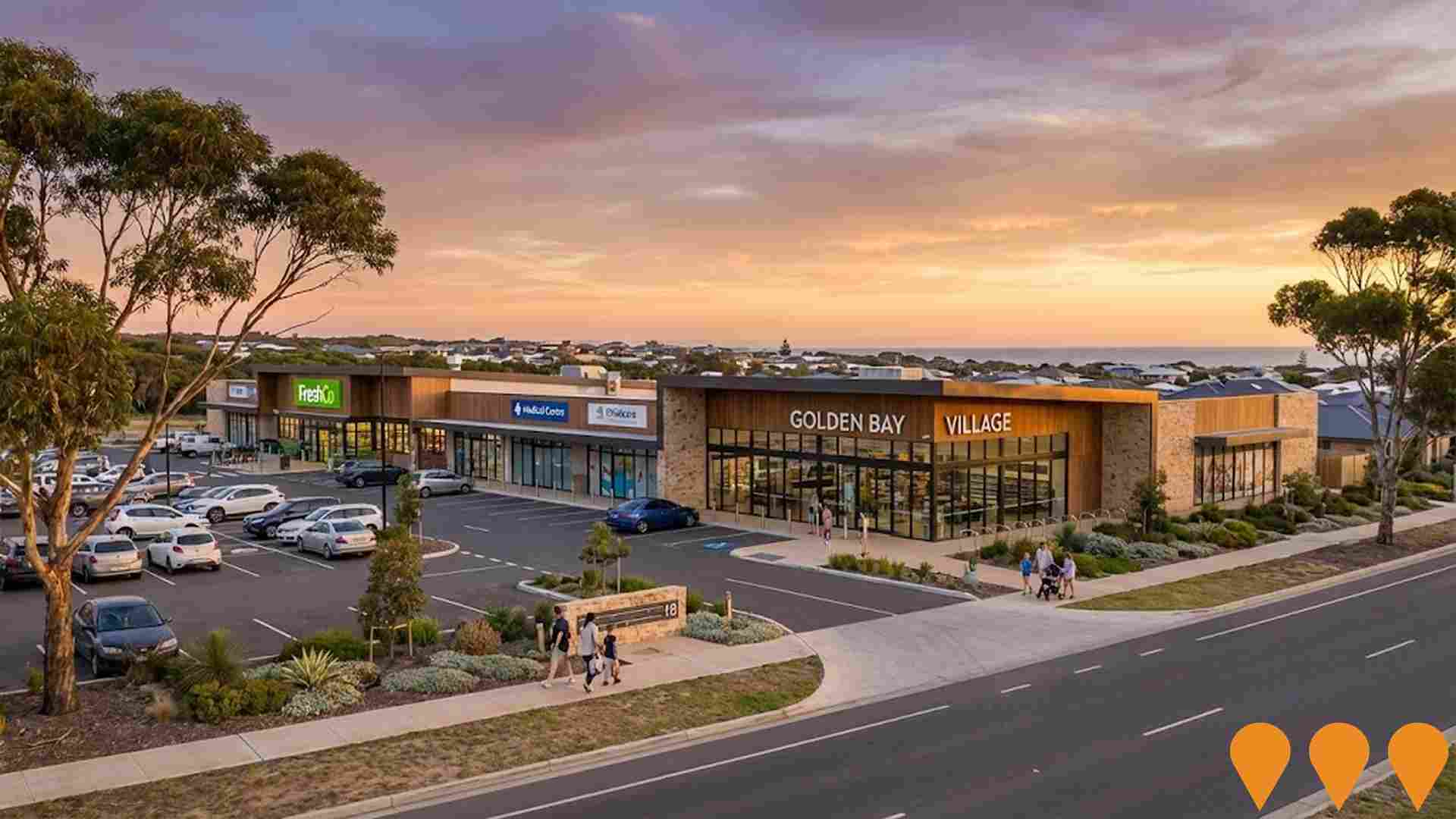
The Gardens Estate - Lakelands
Residential estate development in Lakelands featuring family homes with modern design, parks, and community facilities in a master-planned community setting.

Secret Harbour Community Library
A proposed community library in Secret Harbour to serve the local catchment with lending, programs and study spaces. The project remains in planning and is identified for funding under the City of Rockingham's Development Contribution Plan No.2 (reviewed annually) with no confirmed site or delivery timeframe announced.
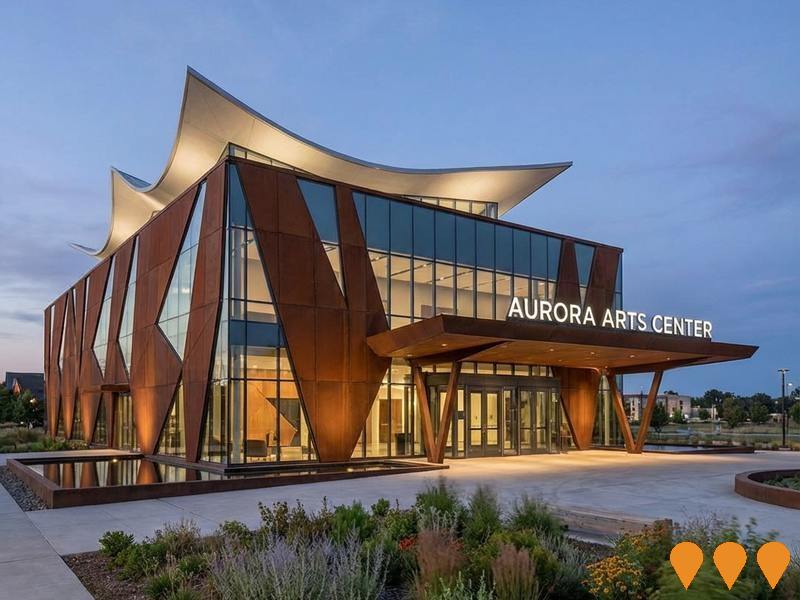
Employment
Employment performance in Karnup exceeds national averages across key labour market indicators
Karnup has a diverse workforce with both white and blue collar jobs. The construction sector is prominent, with an unemployment rate of 3.9% as of June 2025.
Employment growth in the past year was estimated at 4.5%. There are 1,395 residents employed, matching Greater Perth's unemployment rate of 3.9%, but with higher workforce participation at 70.4%. Key employment sectors include construction, health care & social assistance, and retail trade. Karnup specializes in construction, with an employment share 1.4 times the regional level.
Professional & technical services employ only 3.0% of local workers, below Greater Perth's 8.2%. Limited local job opportunities are indicated by Census data comparisons. Between June 2024 and June 2025, employment increased by 4.5%, labour force by 5.8%, leading to a 1.2 percentage point unemployment rise. In contrast, Greater Perth's employment growth was 3.7% and unemployment rose by only 0.1%. National employment forecasts from Jobs and Skills Australia (May 2025) project national growth of 6.6% over five years and 13.7% over ten years. Applying these projections to Karnup's employment mix suggests local growth of approximately 5.6% over five years and 12.2% over ten years, though these are simple extrapolations for illustrative purposes only.
Frequently Asked Questions - Employment
Income
The area exhibits notably strong income performance, ranking higher than 70% of areas assessed nationally through AreaSearch analysis
Karnup had a median taxpayer income of $60,008 and an average of $74,121 based on AreaSearch's aggregation of ATO data from postcodes in financial year 2022. This was higher than the national averages of $58,380 (median) and $78,020 (average) for Greater Perth. By September 2025, estimated incomes would be approximately $68,529 (median) and $84,646 (average), accounting for a 14.2% growth since financial year 2022 as per the Wage Price Index. Income distribution in Karnup clustered around the 70th percentile nationally, with the majority of residents (46.4%, or 1,282 people) falling within the $1,500 - 2,999 income bracket. This was similar to the metropolitan region where this cohort represented 32.0%. Housing costs consumed 16.0% of income in Karnup, yet strong earnings placed disposable income at the 74th percentile nationally. The area's SEIFA income ranking placed it in the fifth decile.
Frequently Asked Questions - Income
Housing
Karnup is characterized by a predominantly suburban housing profile, with ownership patterns similar to the broader region
In Karnup, as per the latest Census evaluation, all dwellings were houses with none being semi-detached, apartments, or other types. This contrasts with Perth metro's 90.5% houses and 9.6% other dwellings. Home ownership in Karnup stood at 17.9%, with mortgaged dwellings at 62.1% and rented ones at 20.0%. The median monthly mortgage repayment was $1,857, higher than Perth metro's average of $1,733. The median weekly rent in Karnup was $370, compared to Perth metro's $330. Nationally, Karnup's mortgage repayments were lower than the Australian average of $1,863, and rents were less than the national figure of $375.
Frequently Asked Questions - Housing
Household Composition
Karnup features high concentrations of family households, with a higher-than-average median household size
Family households account for 85.6% of all households, including 46.8% couples with children, 26.3% couples without children, and 12.2% single parent families. Non-family households make up the remaining 14.4%, consisting of 13.1% lone person households and 1.1% group households. The median household size is 3.0 people, which is larger than the Greater Perth average of 2.6.
Frequently Asked Questions - Households
Local Schools & Education
Karnup performs slightly above the national average for education, showing competitive qualification levels and steady academic outcomes
The area has university qualification rates of 13.2%, significantly lower than the Australian average of 30.4%. This presents both challenges and opportunities for targeted educational initiatives. Bachelor degrees are most common at 8.7%, followed by postgraduate qualifications (2.5%) and graduate diplomas (2.0%). Trade and technical skills are prominent, with 49.2% of residents aged 15+ holding vocational credentials - advanced diplomas (12.6%) and certificates (36.6%).
Educational participation is high at 32.0%, including 13.2% in primary education, 9.2% in secondary education, and 2.9% pursuing tertiary education. Rockingham Montessori School - Karnup Campus provides local educational services within Karnup, with an enrollment of 0 students. All 1 schools offer integrated K-12 education for academic continuity. As no schools are located within Karnup, residents must travel to neighboring areas for educational services. Note: where schools show 'n/a' for enrolments please refer to parent campus.
Frequently Asked Questions - Education
Schools Detail
Nearby Services & Amenities
Transport
Transport servicing is low compared to other areas nationally based on assessment of service frequency, route connectivity and accessibility
The analysis shows one active public transport stop in Karnup, serving a mix of bus routes. This stop is served by one route, offering 412 weekly passenger trips in total. Transport accessibility is rated as limited, with residents typically located 1211 meters from the nearest transport stop.
The service frequency averages 58 trips per day across all routes, equating to approximately 412 weekly trips per individual stop.
Frequently Asked Questions - Transport
Transport Stops Detail
Health
Karnup's residents boast exceedingly positive health performance metrics with younger cohorts in particular seeing very low prevalence of common health conditions
Health outcomes data shows excellent results across Karnup, with younger age groups notably experiencing low prevalence of common health conditions.
Approximately 56% (~1,561 people) of Karnup's total population has private health cover. The most prevalent medical conditions are mental health issues and asthma, affecting 7.8% and 7.2% of residents respectively. A significant majority (74.8%) report being free from medical ailments compared to Greater Perth's 68.5%. Karnup has a lower proportion of seniors aged 65 and over at 10.7% (296 people), compared to Greater Perth's 15.6%. Despite this, health outcomes among seniors in Karnup are above average, indicating a need for targeted attention.
Frequently Asked Questions - Health
Cultural Diversity
In terms of cultural diversity, Karnup records figures broadly comparable to the national average, as found in AreaSearch's assessment of a number of language and cultural background related metrics
Karnup's cultural diversity aligns with the broader area, where 83.5% are citizens, 72.6% were born in Australia, and 93.9% speak English only at home. Christianity is the dominant religion, accounting for 36.3%. The 'Other' religious category is slightly higher than average, at 0.8% compared to Greater Perth's 0.7%.
For ancestry, the top groups are English (34.4%), Australian (28.3%), and Scottish (6.2%). Some ethnicities show notable differences: South African (1.9% vs regional 1.1%), Maori (2.3% vs 2.0%), and New Zealand (1.5% vs 1.2%) are more prevalent in Karnup than the wider region.
Frequently Asked Questions - Diversity
Age
Karnup hosts a very young demographic, ranking in the bottom 10% of areas nationwide
Karnup's median age at present is 30 years, which is notably younger than Greater Perth's average of 37 and significantly below Australia's median of 38. Compared to Greater Perth, Karnup has a higher proportion of residents aged 5-14 (16.9%) but fewer individuals aged 55-64 (8.4%). According to data from the post-2021 Census, the population aged 15-24 has increased from 11.6% to 13.5%, while those aged 35-44 have risen from 12.3% to 14.0%. Conversely, the proportion of residents aged 25-34 has decreased from 19.8% to 16.9%, and the 0-4 age group has fallen from 10.3% to 8.9%. Demographic projections indicate that Karnup's age profile will change significantly by 2041, with the 75-84 age cohort expected to grow substantially, increasing by 110 people (111%) from 100 to 211. Conversely, the number of individuals in the 0-4 age range is projected to decrease.






